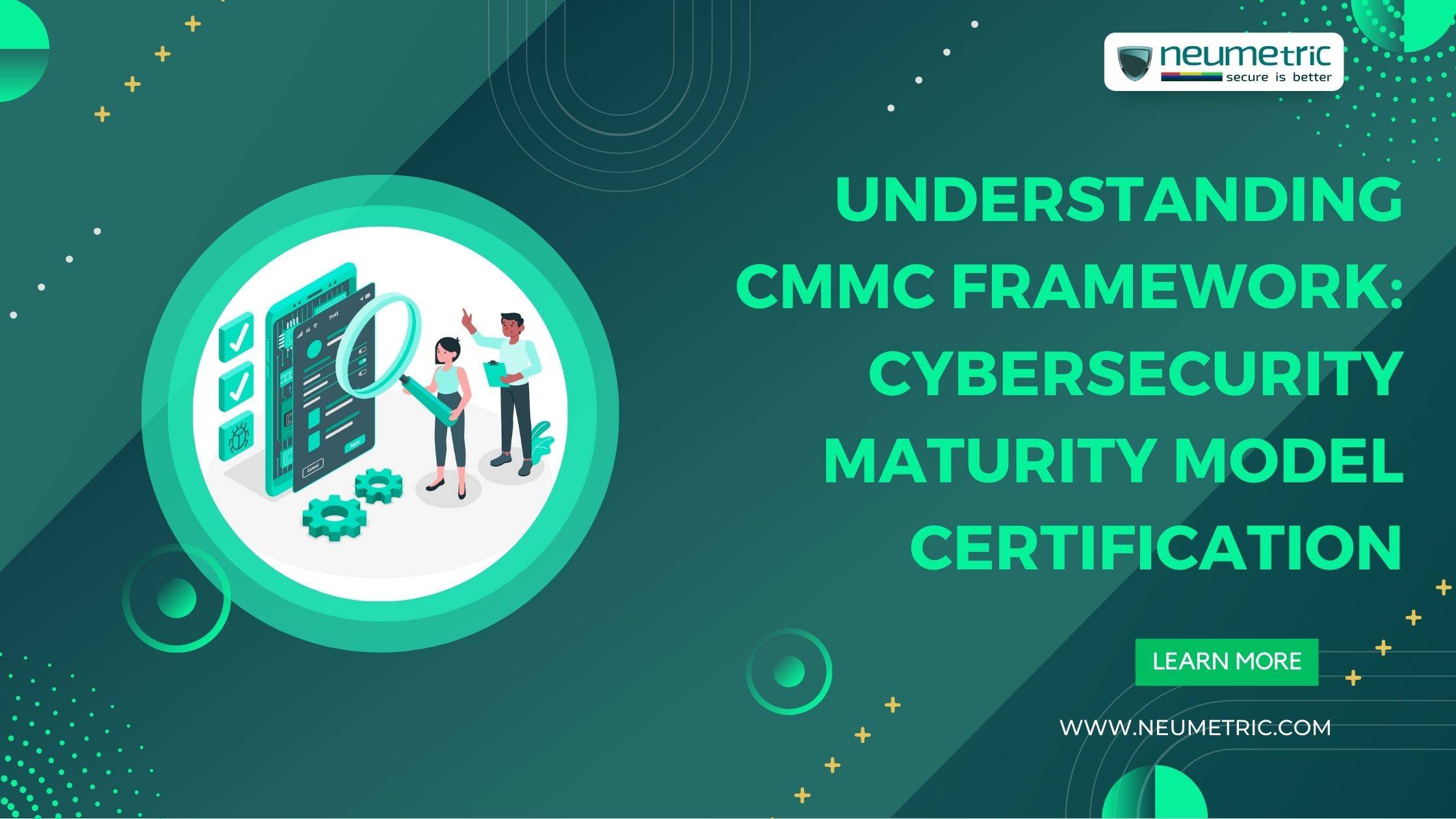Table of Contents
ToggleIntroduction
Cyber threats have grown exponentially in recent years, with attacks becoming more advanced & harder to detect. From ransomware to data breaches, organisations across sectors face immense risk from cybercriminals. This makes robust cybersecurity measures critical for any entity handling sensitive information. The Cybersecurity Maturity Model Certification [CMMC] offers a comprehensive framework to strengthen cyber defences.
This Journal will provide an in-depth understanding of CMMC: its components, implementation, benefits & industry impact. As cyber attacks constantly evolve, the need for standardised maturity models has become evident to safeguard critical systems & data. CMMC aims to be that definitive framework for the defence industry & its supply chain.
With clearly defined maturity processes & best practices, CMMC enables organisations to benchmark & elevate their cybersecurity posture. For defence contractors handling sensitive data, adopting CMMC guidelines has become crucial to continue partnerships with the US Department of Defense. Beyond immediate compliance, CMMC adoption can improve resilience & trust for contractors over the long-term.
What is CMMC?
The Cybersecurity Maturity Model Certification is a certification program that measures the cybersecurity maturity of defence contractors & the resilience of their systems. Developed by the US Department of Defense [DoD], CMMC aims to safeguard sensitive information & strengthen the defence supply chain.
The idea for CMMC emerged since existing requirements left gaps in cyber protection for contractors. After multiple breaches of sensitive defence data through contractors, the urgent need for a unified cybersecurity standard became clear. The CMMC framework builds on principles from other industry standards like NIST SP 800-171 to provide a scalable benchmark for cyber maturity across businesses of different sizes.
The primary objectives of CMMC include increasing visibility into the cyber capabilities of contractors, improving basic cyber hygiene & reducing breaches of DoD information. With multiple maturity processes & cyber best practices, CMMC seeks to accredit the cybersecurity posture of companies in the defence ecosystem.
Understanding the Components of CMMC
The CMMC framework consists of maturity levels, domains, capabilities & processes/practices that defence contractors must meet.
Levels of CMMC
CMMC defines five (5) maturity levels, Level one (1) to Level five (5), that measure a company’s cybersecurity maturity & capabilities. Meeting a specific level signals the ability to protect Controlled Unclassified Information [CUI] data of varying sensitivity levels.
- Level one (1) represents basic cyber hygiene: the fundamental steps organisations should already undertake without CMMC. This includes activities like implementing multi factor authentication & securing data on endpoints.
- Level two (2) incorporates intermediate protection of CUI data via practices like access control & risk audits.
- Level three (3) advances to good cyber hygiene & management of high-risk activities.
- Level four (4) seeks proactive threat detection/mitigation to thwart advanced persistent threats.
- Level five (5) (the highest maturity) involves optimised processes to minimise vulnerabilities & enable rapid response to threats.
Achieving each level requires satisfying a broader set of capabilities tied to seventeen (17) domains.
Domains & Capabilities
CMMC domains categorise cyber practices into specialty areas like access control, asset management, recovery, etc. For instance, the Recovery domain covers capabilities like resilience planning & information preservation. In all, there are forty three (43) cyber capabilities distributed across seventeen (17) domains required by various maturity levels.
Organisations can use the capabilities list to gauge domains where their cyber protections fall short. Strengthening protections as per relevant capabilities will enhance cyber resilience while advancing CMMC maturity.
Processes & Practices
CMMC processes detailed procedural steps to support technical cyber practices. This translates to over three hundred (300) protocols & activities. Some examples are incident reporting processes, reviewing system architecture or access control testing. Instituting sound processes fortifies an organisation’s cyber ecosystem & culture.
Meanwhile, cyber practices outline various technical controls that serve as CMMC safeguards. These span over one hundred and fifty (150) activities like encryption, vulnerability scanning, Intrusion Detection and Prevention Systems [IDPS] & penetration testing. Implementing robust techniques forms a key plank to demonstrate CMMC maturity.
CMMC Implementation & Compliance
Assessing Current Cybersecurity Posture
Firstly, companies should honestly evaluate existing cyber protections regarding coverage areas, policy gaps, technical capabilities & more. This situational analysis highlights domains to prioritise for CMMC readiness. Undertaking an objective assessment allows organisations to build a cybersecurity roadmap rooted in business realities rather than aspirational goals. Companies can leverage CMMC gap analysis tools or work with auditors to diagnose shortfalls across domains, maturity processes, asset security etc. This sets the context to shape an attainable CMMC adoption plan.
Identifying Gaps
The next step is comparing internal cyber maturity with CMMC requirements for a chosen level. This pinpoints capability gaps that require remediation through new solutions, tools or policy updates. Gap analysis will reveal several priorities: whether technical controls like improved encryption, enhanced identity management, adopting certain software solutions or shoring up procedural weaknesses around access control testing for example.
Understanding precise deficiencies that necessitate fixes is key before deploying resources to elevate CMMC posture. It prevents wasting efforts on misplaced priorities during compliance efforts.
Developing a Compliance Roadmap
Companies can then prepare a detailed roadmap that outlines activities, resources & timelines to close protection gaps. The plan should cover budget allocation, asset & tool procurement, employee training, improvement prioritisation & target completion date. Executing such a step-by-step roadmap will systematically bolster CMMC compliance over time.
Benefits of CMMC Certification
Enhanced Cybersecurity Posture
Implementing comprehensive CMMC safeguards significantly elevates defence & resilience against threats. Companies reduce risk surface through layered protections aligned to best practices. Achieving higher CMMC tiers requires instituting advanced capabilities like threat monitoring, incident response teams, penetration testing etc.
Adopting such industry benchmarks curbs vulnerabilities while hindering lateral movement within systems even if breaches occur. This paves the way for resilient operations.
Competitive Advantage
From 2025, CMMC certification will become mandatory for defence contracting. Being early adopters gives companies an edge when bidding for lucrative military projects before others play catch up. With CMMC, DoD can accurately gauge contractor resilience across a range of maturity markers from asset management to regulation compliance. This provides certified businesses credibility in the contracting process over non certified peers.
Further, advertising CMMC compliance signals to private sector clients that an organisation manages threats well beyond basic hygiene. This can open up partnership opportunities beyond defence ecosystems.
Increased Trust & Credibility
Much like ISO certifications, CMMC signals to customers & partners that an organisation takes cybersecurity seriously. This builds immense trust in the brand. Displaying CMMC tier achievements conveys adherence to specific cyber capability standards as mandated by the U.S. government. This reassures stakeholders their data & IP will remain protected while under a contractor’s stewardship.
CMMC & Its Industry Impact
Influencing Defence Contractors
CMMC’s launch aims to bolster protections for close to three lakh (3,00,000) contractors in the defence supply chain. The biggest impact will be on small businesses who may struggle with compliance costs unless they plan budgets ahead of time. For larger enterprises, existing cyber investments may sufficiently cover lower tier CMMC levels.
However, few contractors already meet the requirements for Level four (4) or five (5) currently. This necessitates working closely with auditors, managed service providers & CMMC consultants over the coming years. Contractor ecosystems must also enable information sharing regarding cyber best practices as they implement capabilities.
Relevance in Other Sectors
While initiated for defence contractors, CMMC can deliver value for healthcare companies, financial institutions, tech firms & more. Many are considering adopting CMMC-style models tailored to their context.
For instance, the need for cyber maturity benchmarks has risen within healthcare given proliferation of connected medical devices, patient health data & telehealth platforms. CMMC proves frameworks institutionalising processes work. Surveys already report nearly fifty percent (50%) of hospital executives intend to implement a healthcare-specific CMMC program by 2025.
Implications for SMEs
Becoming CMMC compliant necessitates financial & workforce investments which appears daunting for small & mid sized entities. This is leading many SMEs to explore cost-effective approaches like cyber insurance, vendor partnerships, pooled resources & more.
Government bodies are also proposing provisions to assist SMEs transition – from CMMC education initiatives to subsidising audits. Such measures combined with community collaboration will ease compliance overhead for smaller defence contractors over time.
The Significance of CMMC for Cyber Resilience
This Journal has covered CMMC’s purpose, components, utility, industry relevance & role in strengthening cyber defences. As threats diversify, frameworks like CMMC will grow more pertinent globally. Prioritising resources to achieve CMMC maturity helps fortify information protection & underpins resilient business growth. With sound preparation, forward-looking enterprises across sectors can transform cyber risk into opportunity via CMMC compliance.
Organisations must embrace proactive planning to implement comprehensive safeguards, achieve compliance & signal trustworthiness to customers. Whether pursuing CMMC tiers or tailoring models based on CMMC’s structure, standardised cyber maturity is the future.
FAQ
Does my organisation need full CMMC compliance now?
Not necessarily. CMMC only becomes an explicit prerequisite for defence contracting from 2025. However, many experts recommend contractors start working towards compliance well before that. Achieving Level one (1) or Level two (2) maturity is realistic in the next year or so. This gets you firmly on the path without overstretching resources. You can then build onwards to meet higher tiers based on DoD project timelines.
We are a small biz with under 50 staff. Is attaining high CMMC maturity feasible?
Absolutely, albeit with some diligence. Implementing robust cybersecurity need not correlate directly with company size. The key is understanding your target CMMC level’s capabilities, judicious budget allocation & utilising cost-effective solutions. For instance, you can rely on cloud-based tools to streamline activities like vulnerability scanning without massive infrastructure costs. Small businesses can also pool compliance resources with peers on common suppliers or IT needs.
If we achieve compliance, does that automatically qualify us for defence contracts?
Unfortunately not yet. CMMC maturity levels assess the cybersecurity robustness & data protection abilities of companies. However, DoD will utilise that as just one selection criterion for awarding contracts. You still need to meet other requirements around quality certifications, technical skills, past project experience etc. That said, CMMC tiers will likely see heightened weightage in bid evaluation as adoption spreads. So pursuing the standards remains strongly recommended.





